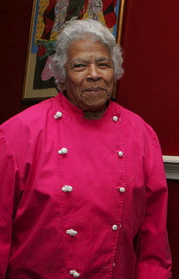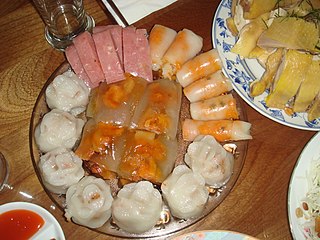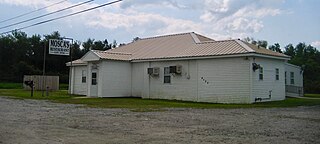| Part of a series on |
| Ethnicity in New Orleans |
|---|

As of 2012 Greater New Orleans has over 14,000 Vietnamese Americans and other people of Vietnamese origins. [1]
| Part of a series on |
| Ethnicity in New Orleans |
|---|

As of 2012 Greater New Orleans has over 14,000 Vietnamese Americans and other people of Vietnamese origins. [1]
Large waves of Vietnamese arrived in New Orleans beginning around 1975 after the Fall of Saigon. [1] One reason why many Vietnamese settled in New Orleans was because of the climate similar to that of Vietnam, and Vietnam was a country colonized by France, not unlike Louisiana itself. In addition, many Vietnamese fleeing were Catholic, [2] and Catholic Charities brought them specifically to New Orleans. [1] The first groups settled in Section 8 properties in the Versailles area of New Orleans East. The first 200 families trickled into New Orleans, half going to the Versailles Apartments in New Orleans East and the other half going to Kingstown Marrero Apartments. Both New Orleans East and the Westbank were settled by the Vietnamese at the same time. [3] In later periods, Vietnamese settlements spread to other parts of the metropolitan New Orleans area including other sections of New Orleans East, Avondale, [2] and the City of Gretna. [4]
The New Orleans East section was flooded by Hurricane Katrina in 2005. Sara Roahen, the author of Gumbo Tales: Finding My Place at the New Orleans Table, wrote that the Vietnamese had been accustomed to hardship and therefore were not as devastated by the effects of the storm, and that of the groups in the flooded zones the Vietnamese had "rallied" the fastest. [5]
Vietnamese American Young Leaders Association of New Orleans (VAYLA-NO) is an area organization for youth. [6]
Vietnamese shrimpers who reside in Plaquemines Parish participate in an annual "Blessing of the Fleet" at the start of brown shrimp season in May. [7]
S. Leo Chiang directed the 2009 television documentary A Village Called Versailles, co-produced by the Independent Television Service and Walking Iris Films. The project was in cooperation with the Center for Asian American Media. [8] The film discusses Vietnamese-American life in New Orleans. [9]
Many Vietnamese living in Versailles are Roman Catholics. Mary Queen of Vietnam, a Vietnamese Catholic church, is in the center of the community. [9]
Thomas Beller of T+L Magazine stated that the use of baguettes and influences from France are the similarities between the cuisine of New Orleans and Vietnamese cuisine. [4]
Vietnamese restaurants opened in Vietnamese communities in New Orleans East and the West Bank after 1975. After the first immigrant generation arrived, many opened seafood and Chinese American restaurants out of the belief that they were more likely to succeed compared to Vietnamese restaurants. By 2014 Vietnamese restaurants had opened outside of Vietnamese communities, such as in the East Bank of New Orleans. The owners of these newer restaurants were born and/or raised in the United States. [10]
In New Orleans banh mi are called "Vietnamese poboys". [1] Crystal hot sauce is served with pho in New Orleans restaurants. Crawfish is a common element with both the native New Orleans cuisine and the Vietnamese cuisine. Elizabeth M. Williams, author of New Orleans: A Food Biography, wrote that "there is little need for Asian Cajun restaurants" due to the fact that "spicy crawfish boils are so easy to find in New Orleans". [1]
Williams wrote that many Vietnamese easily learned how to make king cakes since baguettes are a part of Vietnamese cuisine. Many New Orleans-area restaurants have two soups of the day, with one being a gumbo and the other being a pho. The pickled vegetables seen in banh mi are now available as fillings for po boys in traditional po boy restaurants. Many New Orleans restaurants also have chayote (mirliton) spring rolls. [1]
As of 2008 [update] many Vietnamese in Village de l'Est grow vegetables in gardens. [11] Other popular crops include mangoes, mint, taro, squash, and bananas. [7]
The Vietnamese New Year (Tet) is celebrated in New Orleans East. [12]

Cajun cuisine is a style of cooking developed by the Cajun–Acadians who were deported from Acadia to Louisiana during the 18th century and who incorporated West African, French and Spanish cooking techniques into their original cuisine.

Vietnamese cuisine encompasses the foods and beverages of Vietnam. Meals feature a combination of five fundamental tastes : sweet, salty, bitter, sour, and spicy. The distinctive nature of each dish reflects one or more elements, which are also based around a five-pronged philosophy. Vietnamese recipes use ingredients like lemongrass, ginger, mint, Vietnamese mint, long coriander, Saigon cinnamon, bird's eye chili, lime, and Thai basil leaves. Traditional Vietnamese cooking has often been characterised as using fresh ingredients, not using much dairy or oil, having interesting textures, and making use of herbs and vegetables. The cuisine is also low in sugar and is almost always naturally gluten-free, as many of the dishes are rice-based instead of wheat-based, made with rice noodles, papers and flour. Vietnamese cuisine is strongly influenced not only by the cuisines of neighboring China, Cambodia and Laos, but also by French cuisine due to French colonial rule over the region from 1887 to 1954.

Louisiana Creole cuisine is a style of cooking originating in Louisiana, United States, which blends West African, French, Spanish, and Native American influences, as well as influences from the general cuisine of the Southern United States.

Gumbo is a stew popular in the U.S. state of Louisiana, and is the official state cuisine. Gumbo consists primarily of a strongly flavored stock, meat or shellfish, a thickener, and the Creole "holy trinity" – celery, bell peppers, and onions. Gumbo is often categorized by the type of thickener used, whether okra or filé powder.

Jambalaya is an American Creole and Cajun rice dish of French, African, and Spanish influence, consisting mainly of meat and vegetables mixed with rice and spices.

Kim Sơn is a family-owned chain of restaurants in Houston, Texas, that serves both Vietnamese cuisine and Chinese cuisine. As of 2009 Tri La is the owner of the restaurant group. The restaurant group headquarters is in its East Downtown restaurant.

A po' boy is a sandwich originally from Louisiana. It traditionally consists of meat, which is usually roast beef, ham, or fried seafood such as shrimp, crawfish, fish, oysters, or crab. The meat is served in New Orleans French bread, known for its crisp crust and fluffy center.

In Vietnamese cuisine, bánh mì or banh mi is a short baguette with thin, crisp crust and a soft, airy texture. It is often split lengthwise and filled with meat and savory ingredients like a submarine sandwich and served as a meal, called bánh mì thịt. Plain bánh mì is also eaten as a staple food.

Leyah (Leah) Chase was an American chef based in New Orleans, Louisiana. An author and television personality, she was known as the Queen of Creole Cuisine, advocating both African-American art and Creole cooking. Her restaurant, Dooky Chase, was known as a gathering place during the 1960s among many who participated in the Civil Rights Movement, and was known as a gallery due to its extensive African-American art collection. In 2018 it was named one of the 40 most important restaurants of the past 40 years by Food & Wine.

Gỏi cuốn, or nem cuốn, salad roll, summer roll, fresh spring roll, spring roll, rice paper roll, is a Vietnamese dish traditionally consisting of pork, prawn, vegetables, bún, and other ingredients wrapped in bánh tráng. Unlike other spring roll dishes, which are believed to originate from China, Vietnamese gỏi cuốn is a national creation using bánh tráng.

Bánh xèo is a crispy, stuffed rice pancake popular in Vietnam. The name refers to the sound a thin layer of rice batter makes when it is poured into the hot skillet. It is a savoury fried pancake made of rice flour, water, and turmeric powder. It can also be called a Vietnamese crêpe. Some common stuffings include pork, prawns, diced green onion, mung bean, and bean sprouts. Bánh xèo is often served with sides. Usually, some commonly added ingredients include leafy greens like lettuces or perilla leaves, other herbs as flavor enhancers like mint leaves and Thai basil, cucumbers, and pickled vegetables, usually carrots and radishes. Lastly, its dipping sauce is Nước chấm. Elements of each side and sauce add to the fresh-tasting fried Bánh Xèo.

In Vietnamese, the term bánh translates loosely as "cake" or "bread", but refers to a wide variety of prepared foods that can easily be eaten by hands or chopsticks. With the addition of qualifying adjectives, bánh refers to a wide variety of sweet or savory, distinct cakes, buns, pastries, sandwiches, and other food items, which may be cooked by steaming, baking, frying, deep-frying, or boiling. Foods made from wheat flour or rice flour are generally called bánh, but the term may also refer to certain varieties of noodle and fish cake dishes, such as bánh canh and bánh hỏi.
The culture of Louisiana involves its music, food, religion, clothing, language, architecture, art, literature, games, and sports. Often, these elements are the basis for one of the many festivals in the state. Louisiana, while sharing many similarities to its neighbors along the Gulf Coast, is unique in the influence of Louisiana French culture, due to the historical waves of immigration of French-speaking settlers to Louisiana. Likewise, African-American culture plays a prominent role. While New Orleans, as the largest city, has had an outsize influence on Louisiana throughout its history, other regions both rural and urban have contributed their shared histories and identities to the culture of the state.
A pistolette is either of two bread-based dishes in Louisiana cuisine. One is a fried bread roll, that can also be stuffed, in the Cajun areas around Lafayette and Lake Charles. The other is a type of submarine shaped bread about half the size of a baguette that is popular in New Orleans for Vietnamese bánh mì and other sandwiches. In France and Belgium, the word pistolet refers to a round roll.

Mosca's is a Louisiana Creole Italian restaurant in Waggaman, Louisiana, near New Orleans. Operated by the same family since it opened in 1946, it has long been regarded as one of New Orleans' best restaurants, known for dishes such as Oysters Mosca, crab salad, Chicken a la Grande, and pineapple fluff.

This article discusses the various cuisines in Houston, Texas.

Dong Phuong Oriental Bakery is a Vietnamese retail and wholesale bakery, restaurant, and catering business in New Orleans, Louisiana. It is known for supplying the baguette style bread for many of the city's restaurants that offer banh mi or other sandwiches, and has its own popular banh mi counter. The bakery, along with the nearby Mary Queen of Vietnam Catholic Church, were fixtures of the Vietnamese community in New Orleans even before surviving the devastation of Hurricane Katrina. It is located at 14207 Chef Menteur Highway in the "Little Vietnam" section of Eastern New Orleans. It is attached to a sit-down restaurant of the same name that serves a variety of Vietnamese and Chinese dishes, including phở, bún thịt nướng, bún riêu, and bánh hỏi.

The cuisine of New Orleans encompasses common dishes and foods in New Orleans, Louisiana. It is perhaps the most distinctively recognized regional cuisine in the United States. Some of the dishes originated in New Orleans, while others are common and popular in the city and surrounding areas, such as the Mississippi River Delta and southern Louisiana. The cuisine of New Orleans is heavily influenced by Creole cuisine, Cajun cuisine, and soul food. Later on, due to immigration, Italian cuisine and Sicilian cuisine also has some influence on the cuisine of New Orleans. Seafood also plays a prominent part in the cuisine. Dishes invented in New Orleans include po' boy and muffuletta sandwiches, oysters Rockefeller and oysters Bienville, pompano en papillote, and bananas Foster, among others.

Domilise's Po-Boy and Bar is an uptown New Orleans restaurant known for its po-boy sandwiches. The restaurant was founded in the 1930s by the Domilise family, who lived in the house above the single-room bar/dining area, and was run by Sam and Dorothy “Miss Dot” Domilise for over seventy-five years until her death in 2013. The restaurant was closed during 2005's Hurricane Katrina while the family evacuated to Alabama and to Franklin, Louisiana.

Bánh bao bánh vạc are a regional specialty of Vietnamese cuisine peculiar to Hội An. The rice paper is translucent and wrapped to resemble a flower shape. Said to be made with water from a certain well in Hội An, this dumpling is not found anywhere else. The filling is prepared with a mix of shrimp, mushrooms, bean sprouts and spring onions. The dough is made by mixing rice flour with water and pounding the mixture in a mortar. The preparation of the dough is rumored to be a family secret. The full meal bánh bao bánh vạc consists of seven bao style dumplings filled with shrimp paste, and three shell-shaped vac dumplings filled with shredded vegetables. The finished dish is topped with fried shallots and served with nước mắm chấm.